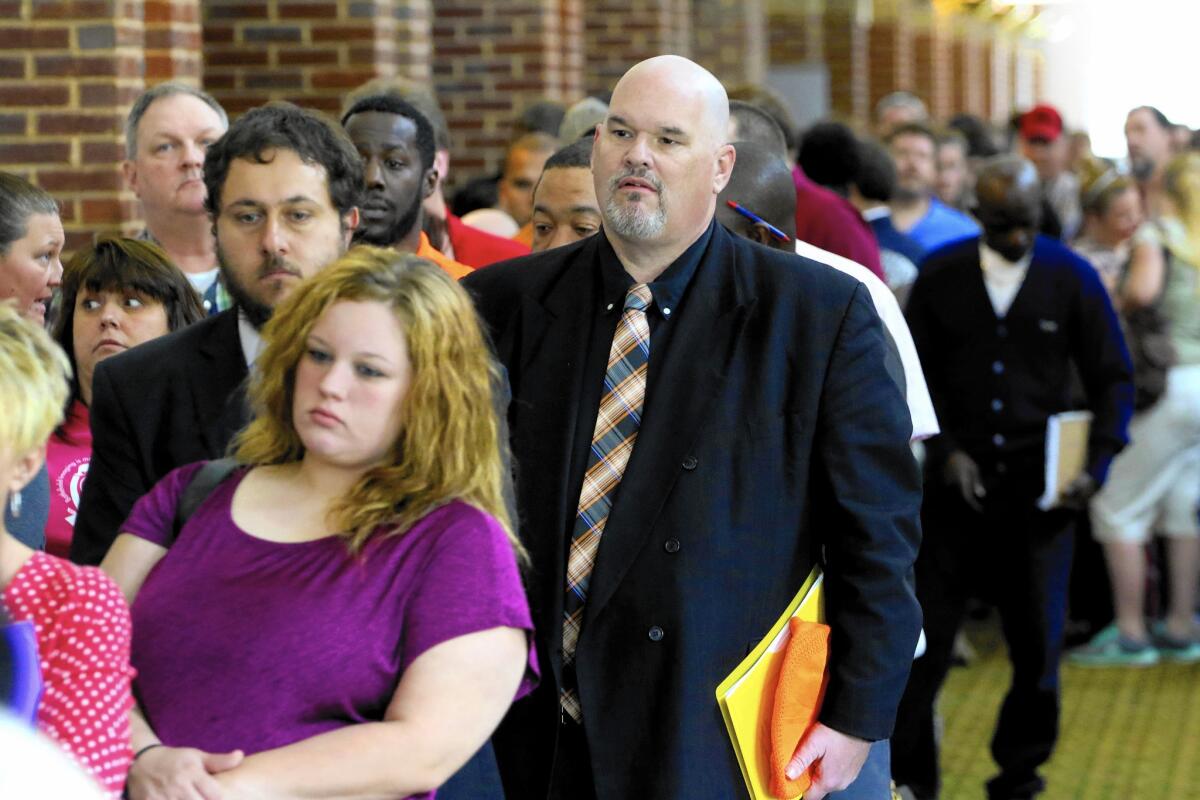U.S. firms add 201,000 jobs in May, ADP says

Job gains in May were mostly in the service sector, which accounted for 95% of the new jobs, according to ADP. Above, job seekers at a career fair in Georgia.
The private sector added 201,000 jobs in May, a robust improvement over the previous month and a sign the economic recovery is getting back on track, according to payroll firm Automatic Data Processing Inc.
And a Commerce Department report showing that April’s trade deficit plummeted 19% in April provided further evidence that the effects of the West Coast port dispute during the winter were short-lived.
The department reported that the nation’s trade deficit fell in April to $40.9 billion from $50.6 billion in March. Longer term trends were largely unchanged, with the trade deficit showing a modest $500-million decrease for the first three months this year.
In its monthly jobs report, ADP said small businesses with 50 or fewer employees led the way, adding 122,000 of the new jobs, while firms larger than 1,000 employees contributed only 16,000. The job gains were overwhelmingly in the service sector, which accounted for 95% of the new jobs.
The May report on nonfarm, private sector payrolls increased from April’s revised figures of 165,000 new jobs and indicated that an economic contraction in the first quarter should be reversed in the second quarter ending this month.
“The job market posted a solid gain in May,” said Mark Zandi, chief economist at Moody’s analytics, which prepared the report in collaboration with ADP. “Employment growth remains near the average of the past couple of years. At the current pace of job growth, the economy will be back to full employment by this time next year.”
The ADP findings are closely watched as a harbinger of the Labor Department’s more comprehensive monthly jobs report, which is to be released Friday. ADP’s job-growth figures for April were significantly lower than the Labor Department’s, and economists generally caution against reading too much into the firm’s data.
Patrick J. O’Hare, chief market analyst at briefing.com, said the ADP figures show reasonably robust jobs growth but with some signs that the rate of job creation is slowing.
“It’s a good report, but there’s room for it to be better,” he said, noting that the numbers are unlikely to shift economists’ expectations for Friday’s Labor Department report to show a gain of 225,000.
The ADP report comes five days after the Commerce Department reported that the U.S. economy had contracted in the first quarter for the second straight year, shrinking at an annualized rate of 0.7%. Economists chalked up most of the slowdown to bad winter weather and the West Coast ports dispute.
In May, the construction sector added 27,000 jobs, up slightly from April and March, while trade, transportation and utilities, which would have been most affected by the port dispute, snapped backed smartly, contributing 56,000 of the new jobs, ADP said.
Even so, economists said the report contains some worrisome signs.
Manufacturing jobs fell by 5,000, the third straight monthly decline, showing that the persistent strength of the dollar continues to slow U.S. sales abroad. And the dramatic decline in oil prices, off more than 40% from a year ago, continues to hurt the energy sector, which has shed more than 40,000 jobs since peaking in November 2014, ADP said.
Wall Street analysts are poring over jobs figures as a predictor of when the Federal Reserve will raise interest rates, which have been near zero since the Great Recession.
The first quarter’s soft figures have given the Fed some leeway, but continued job growth adds to the pressure on policymakers to raise rates, Russ Ostrich, BlackRock Inc.’s global chief investment strategist, said in a recent note.
“Given that the United States is creating jobs at the fastest pace since the late 1990s,” he wrote, “it is increasingly difficult to justify a 0% policy rate.”







